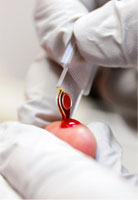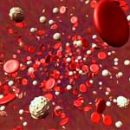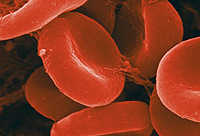Aplastic anemia is a blood illness with a violation of bone marrow ability to produce blood cells. Early symptoms of the disease are weakness, increased fatigue, poor tolerance of stuffed premises and the appearance of bleeding.
Content
Concept of aplastic anemia
Aplastic anemia is a blood disease, consisting in violation of the ability of bone marrow to produce three main types of blood cells. For the first time, this disease was described by Paul Erlich in 1888. Term «Aplastic anemia» was proposed at the beginning of the XX century (from the word «Aplasia», Meaning the absence of something or underdeveloped).
Aplastic anemia is quite rare disease, it is more common in people of young age, equally often in men and women.
In aplastic anemia, there is a decrease in the number of white blood cells (leukopenia) - this is the first component of the disease and the second component - lack of platelets (thrombocytopenia), which leads to an increased risk of infections or bleeding, which are the main causes of death in children with aplastic anemia. There is also a third component - anemia caused by the lack of red blood cells.
The reasons for the development of aplastic anemia
Among the main reasons for the development of aplastic anemia, increased sensitivity to the medication preparation (idiosyncrasy) plays a major role. Most often aplastic anemia is caused by chloramphenicol (levomycetin), sulfonilamides, tetracycline, streptomycin, butadion, gold, barbiturates, buccarboat, decaris, antihyroid and antihistamines.
Among physical factors, it is necessary to allocate the effects of ionizing radiation. Increased incidence of applications of aplastic anemia in patients who received radiation therapy for diseases of the bone-topic device, as well as radiologists and radiologists.
In some patients with aplastic anemia, the development of the disease is associated with infectious diseases, such as viral hepatitis (A, B and C). In addition to the hepatitis virus, aplastic anemia can cause Epstein-Barr virus, herpes virus, parvaruses and human immunodeficiency virus (HIV).
Symptoms of aplastic anemia
It is customary to distinguish between 2 main groups of aplastic anemia:
- Congenital (Constitutional anemia of Fanconi)
- acquired as a result of the impact of a number of external factors
Early symptoms of aplastic anemia include general weakness, increased fatigue, dizziness, ears, bad tolerance of stuffed premises, the appearance of bleeding (nasal, uterine, gastrointestinal, hemorrhage in the skin), unmotivated bruises, bone pain and joints. Gradually grow the pallor of the skin and mucous membranes. With congenital forms of aplastic anemia, the skin has a characteristic ashton. The liver is somewhat increased. Spleen and peripheral lymph nodes are not increased.
Children with aplastic anemia increases the oppression of the bone marrow function.
Aplastic anemia is usually characterized by a heavy or easy course. With the easiest course of aplastic anemia, the number of red blood cells is not reduced very much. Sometimes the lack of one of the types of blood cells prevails, causing a serious course of aplastic anemia.
Often an easy form of aplastic anemia develops into a hard form. In case of moderate severity, bleeding from the nose can occur periodically, sometimes not heavy infections and light anemia. With a severe course of the disease, the patient constantly suffers from strong, long bleeding, frequent and severe infections, pronounced anemia.
The most common and most severe form of aplastic anemia - anemia of Fanconi. Children with Fanconi anemia often have flavors of kidney or bones. Vices of the development of thumb and wrist bones are most often. Kidney developmental defects can affect one kidney, additional kidneys may occur or improper kidney location.
Treatment of the disease
 Treatment provides only temporary control over the disease. However, among young children with severe disease, which receive the recommended forms of treatment (bone marrow transplant), four out of five survive and are considered fully healing.
Treatment provides only temporary control over the disease. However, among young children with severe disease, which receive the recommended forms of treatment (bone marrow transplant), four out of five survive and are considered fully healing.
Treatment of aplastic anemia is a very difficult task. The first and most important step in treatment is the elimination of all factors that can cause anemia. The second step is the careful use of blood preparations. However, the main and only pathogenetic method of treatment of aplastic anemia, allowing to count on the salvation of the patient's life, is bone marrow transplantation from a compatible donor conducted in special transplantation centers. The transplantation must be carried out as soon as possible after the diagnosis. Without bone marrow transfers, the disease quickly progresses and for several months leads to death.
Children with aplastic anemia that no bone marrow transplant was made, can not be considered fully healing, despite the prolonged improvement, until the number of blood cells normalizes. In patients with apparent recovery from aplastic anemia in a few years, recurrence of the disease. Even during the improvement, the number of blood cells is below the norm, however, for several decades, the degree of reduction may be above the dangerous limits. The frequency of disease leukemia in patients with aplastic anemia is higher than in patients without aplastic anemia.
If it is impossible to choose a donor as a basic drug used immunosuppressant Cyclosporin A. In patients with non-heavy aplastic anemia, the use of this drug allows you to count in some cases. Currently, major research centers continue to study new types of treatment of aplastic anemia.









